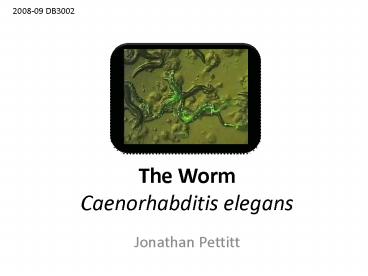The Worm Caenorhabditis elegans - PowerPoint PPT Presentation
1 / 29
Title:
The Worm Caenorhabditis elegans
Description:
Early embryogenesis of. C. elegans: the founder cells. Polarity in the early C. elegans embryo ... Germline cell fate determination during early embryogenesis ... – PowerPoint PPT presentation
Number of Views:150
Avg rating:3.0/5.0
Title: The Worm Caenorhabditis elegans
1
The WormCaenorhabditis elegans
2008-09 DB3002
- Jonathan Pettitt
2
C. elegans as a model organism
- Advantages
- Disadvantages
- Simple anatomy
- Comprehensive description of development at
single cell resolution - all cells visible throughout lifecycle
- Ease of genetic analysis
- Mutant screening is rapid and can be automated in
some cases - RNA interference is highly effective
- Simple anatomy
- Small size and egg shell make embryo difficult to
study by microsurgery - But it can be done!
- No cell lines for cell culture analysis
3
Adult anatomy
4
Him and Her
- Males arise via X-chromosome non-disjunction
(they are XO hermaphrodites are XX) - This occurs naturally at a low rate (0.1-0.2),
but can be increased by certain muations (high
incidence of males him mutants)
5
Lifecycle
6
Embryonic Development
7
Embryonic Development
8
The Cell Lineage and The Nobel Prize
9
1 cell
959 cells
10
A cell lineage of the early embryo
fertilised egg
t i m e
P1
AB
EMS
P2
ABp
ABa
11
The Cell Lineage
12
Early embryogenesis of C. elegans the founder
cells
13
Polarity in the early C. elegans embryo
- sperm entry determines A-P axis, by providing
centrosomes - the maternal and paternal pronuclei meet and
migrate to midpoint of A-P axis - p-granules become localised to posterior
- mitotic spindle becomes displaced posteriorly
- embryo divides unequally to produce AB and P1
14
Polarity in the early C. elegans embryo
- sperm entry determines A-P axis, by providing
centrosomes - the maternal and paternal pronuclei meet and
migrate to midpoint of A-P axis - p-granules become localised to posterior
- mitotic spindle becomes displaced posteriorly
- embryo divides unequally to produce AB and P1
15
Polarity in the early C. elegans embryo
- sperm entry determines A-P axis, by providing
centrosomes - the maternal and paternal pronuclei meet and
migrate to midpoint of A-P axis - p-granules become localised to posterior
- mitotic spindle becomes displaced posteriorly
- embryo divides unequally to produce AB and P1
16
Polarity in the early C. elegans embryo
- sperm entry determines A-P axis, by providing
centrosomes - the maternal and paternal pronuclei meet and
migrate to midpoint of A-P axis - p-granules become localised to posterior
- mitotic spindle becomes displaced posteriorly
- embryo divides unequally to produce AB and P1
17
- Anterior-Posterior Axis
- Sperm entry point determines future
anterior-posterior axis - P granule localisation correlates with
- posterior of the embryo
- germline cell fate
- Germline, P cells express PIE-1 TF
18
Polarity in the early C. elegans embryo
- sperm entry determines A-P axis, by providing
centrosomes - the maternal and paternal pronuclei meet and
migrate to midpoint of A-P axis - p-granules become localised to posterior
- mitotic spindle becomes displaced posteriorly
- embryo divides unequally to produce AB and P1
19
Germline cell fate determination during early
embryogenesis
- At each division of Pn cells, one daughter
becomes a somatic cell, the other, posterior
daughter inherits P-granules
20
Maternal-effect
- Most early gene products are provided entirely by
the mother - Mutations in these genes show a strict
maternal-effect - homozygous mutant progeny of heterozygote mothers
are viable - progeny of homozygous mutant mothers all arrest
development
21
Maternal effect mutations
m
m
m
All progeny viable
All progeny arrested as embryos
22
The Par mutants
- Kemphues et al screened for maternal effect
embryonic lethal mutations - Identified par (partioning defective) mutants
which show defects in AB and P1 cell fates
F2
F3
23
par-3, par-6, pkc-3 mutants
- Mutant Phenotype
- AB spindle same orientation as P1
- In absence of PAR-3, PAR-6 or PKC-3 both cells
behave like P1 - All three proteins localise to AB cell
wild-type
par-3 mutant
24
par-1 mutants
par-2 mutants
- Normal AB and P1 cells
- P granules fail to segregate to P1
- both cells same size
- P1 spindle same orientation as AB
- Both cells behave like AB cells
WT
par-2
par-1
25
Polarity in the early embryo is controlled by the
PAR proteins
- PAR-3,-6 and PKC-3 define the anterior region of
the cell - PAR-2 defines the posterior region of the cell
- PAR-3 localisation is dependent upon PAR-2
function, and vice-versa
PAR-3
PAR-2
26
MEX-5/-6 regulate cell fate in the early embryo
- mex-5 and mex-6 encode almost identical proteins
- mex-5/-6 double mutants misexpress posterior
proteins in anterior cells
27
PAR-3, PAR-2 and PIE-1
PAR-3
PAR-2
28
MEX-5 expression
- MEX-5 expression is highest in the somatic
daughter of Pn at each cell division, i.e. the
reciprocal of germline proteins
29
Summary Model
- In response to sperm-entry point PAR proteins
ensure the proper segregation of MEX-5/6 proteins
and thereby ensure proper partitioning of cell
fate































